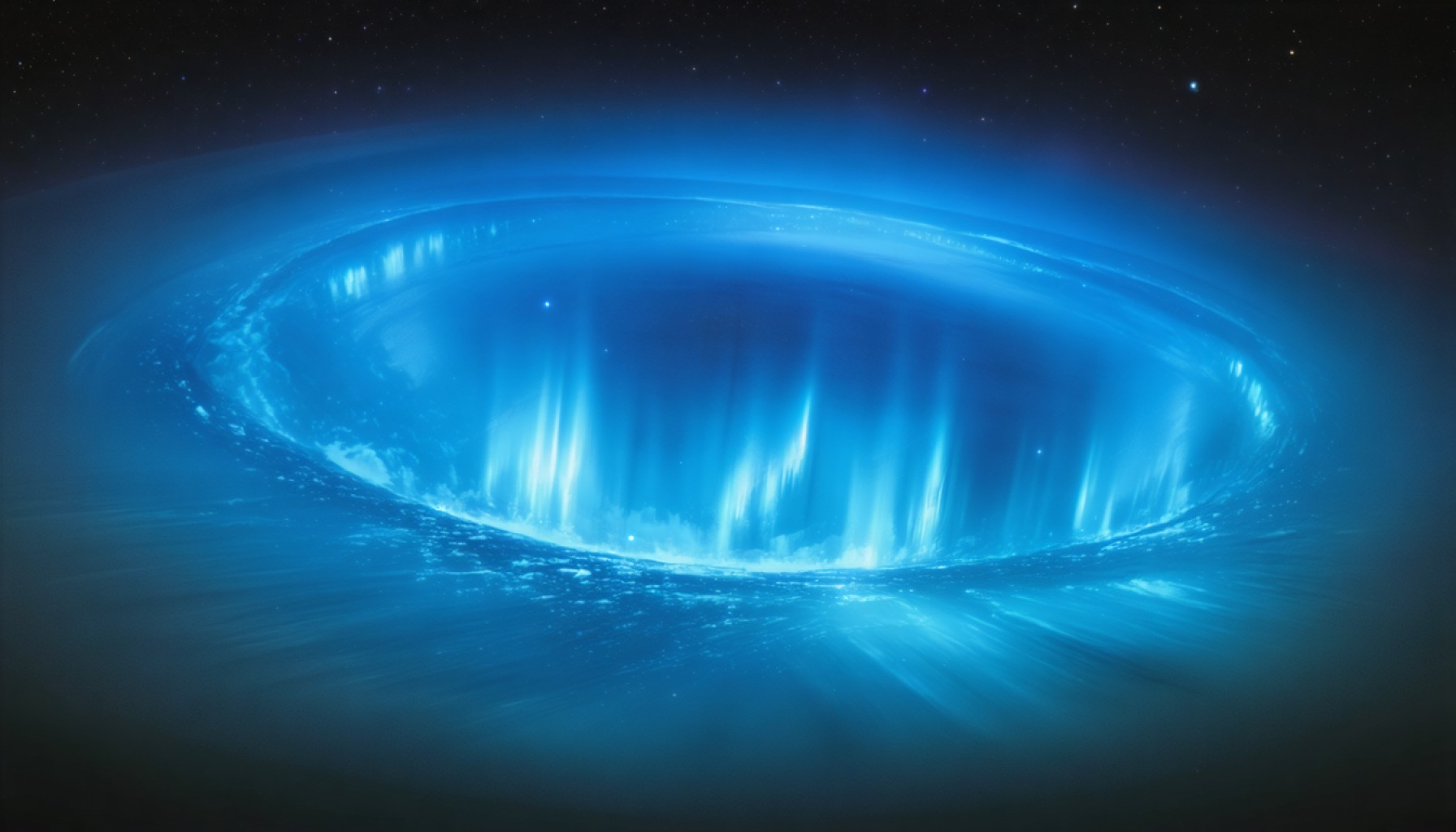- The James Webb Space Telescope has captured images of Neptune’s auroras at mid-latitudes, a phenomenon not seen before on this ice giant.
- These auroras, visualized in bright cyan hues, were detected using the telescope’s Near-Infrared Spectrograph in June 2023.
- Neptune’s auroras are caused by energetic particles interacting with atmospheric gases, revealing unique insights into the planet’s magnetic field and atmospheric dynamics.
- Previously hinted at by Voyager 2’s flyby in 1989, these auroras have now been captured with unprecedented detail thanks to Webb’s sensitivity.
- The detection included the robust emission line of the trihydrogen cation, a molecule associated with auroral energy.
- These observations challenge existing understanding and spark curiosity about Neptune’s atmospheric processes and magnetic behavior.
- The findings illuminate the cosmic environment beyond Earth, enhancing our understanding of space and inspiring further exploration.
Peering into the enigmatic reaches of our solar system, NASA’s James Webb Space Telescope has unveiled a mesmerizing spectacle—the shimmering auroras of Neptune. Unlike the reassuring glows near Earth’s poles, Neptune’s celestial dance of charged particles occurs at unexpected mid-latitudes. These stunning images, captured using Webb’s Near-Infrared Spectrograph in June 2023, reveal the auroras as bright cyan jewels set against the planet’s icy canvas. This extraordinary achievement ignites the imagination and deepens the mysteries of the distant ice giant.
The phenomenon of auroras is not confined to Earth. When energetic particles get ensnared by a planet’s magnetic embrace and collide with atmospheric gases, they paint the sky with ethereal colors. On Neptune, these forces collude to produce a spectacle that had long eluded astronomers. Voyager 2’s 1989 flyby sparked the initial curious whispers of Neptune’s auroral activity, but the images retrieved were fleeting glimpses at best.
Now, with an unrivaled sensitivity to infrared light, the James Webb Telescope has accomplished what was once a distant aspiration. It detected a robust emission line from the trihydrogen cation, a molecule that thrives on the volatile energy of auroral events. The sighting is not just a scientific triumph but also an artistic marvel, creating images that herald a new age of astrological understanding.
The revelations from Webb extend beyond mere visual allure; they provide insight into the dynamic processes churning beneath Neptune’s azure surface. The auroras’ positions at mid-latitudes challenge our understanding of magnetic fields and atmospheric interactions on distant planets. These findings prompt tantalizing questions—what other phenomena might be lurking, awaiting discovery?
As we ponder Neptune’s glowing embrace, the achromatic void of space appears a little less empty, a little more alive. The James Webb Space Telescope has brought us closer not just to Neptune’s atmospheric secrets, but to the enduring wonder of the universe. Here lies the true beauty of exploration—each revelation draws us deeper into the cosmos, continually rewiring our perception of what is possible across the unfathomable stellar distances.
Discover Neptune’s Unique Auroras: Insights from the James Webb Space Telescope
Unveiling the Mysteries of Neptune’s Auroras
The recent observations of Neptune’s auroras by the James Webb Space Telescope have opened new doors in our understanding of the dynamic interactions within our solar system. These spectacular images are more than just a visual treat; they hold key insights into Neptune’s atmospheric and magnetic phenomena that intrigue scientists worldwide.
Key Facts About Neptune’s Auroras
1. Aurora Composition:
Neptune’s auroras are composed of both charged particles from the solar wind and particles from its magnetosphere, exciting gases high in its atmosphere. The trihydrogen cation (H3+) plays a significant role, emitting infrared light that Webb’s instruments detected.
2. Unexpected Locations:
Unlike Earth’s auroras, concentrated near the poles, Neptune’s are found at mid-latitudes. This challenges existing models of how magnetic fields and atmospheric gases interact on distant planets.
3. Enhanced Understanding of Magnetic Fields:
Neptune’s complex and dynamic magnetic field—tilted and offset from its rotational axis—is key in generating mid-latitude auroras. This insight prompts scientists to revisit how we understand planetary magnetic fields on other planets too.
4. Collaborative Discovery with Voyager 2:
Initial observations by Voyager 2 hinted at Neptune’s auroral activity, but with limited data. The James Webb Telescope’s advanced capabilities provide clearer, more comprehensive data sets, advancing decades-old leads.
Practical Applications and Implications
– Astrophysics Advancements: This discovery could lead to refined models for other gas and ice giants, enhancing our interpretation of their magnetic and atmospheric activities.
– Potential for Future Missions: As research progresses, there might be discussions about sending probes specifically to study Neptune’s magnetic field and atmosphere in more detail.
– Educational Initiatives: The findings can stimulate curriculum updates in astrophysics and planetary sciences to include real-world, up-to-date data in academic settings.
Industry Trends and Predictions
1. Astronomy Technology Advancements:
– Over the coming years, we expect continual enhancements in telescopic technologies, bolstering our understanding of distant planets.
– There is growing interest in investing in complementary technologies that support space telescopes, such as AI-driven data analysis tools.
2. Focus on Exoplanetary Atmospheric Research:
– Insights from Neptune feed into exoplanet studies, as researchers apply similar methodologies to understand exoplanet atmospheres.
Pros and Cons Overview
Pros:
– Offers unprecedented insights into Neptune’s auroras, shedding light on its magnetic interactions.
– Stimulates further exploration and scientific inquiry into Neptune and similar icy planets.
Cons:
– Limited by the telescope’s operational field, capturing only specific spectra and locales at a time.
– Interpreting data requires assumptions, leading to potentially variable conclusions.
Actionable Recommendations
– Stay Informed: Follow NASA’s main website for updates on Webb’s findings.
– Engage with Educational Content: Enhance your understanding by attending webinars and reading scientific papers on the James Webb Telescope’s discoveries.
– Support Scientific Missions: Engage with and support policies that promote space exploration and research funding.
As we unravel the mysteries of our solar system with every discovery, the cosmos becomes not just a realm to understand but to dream about and explore. These findings from the James Webb Space Telescope propel us towards a future where the secrets of the universe are within our reach.
